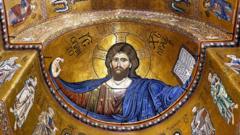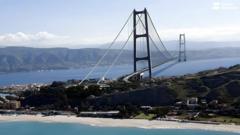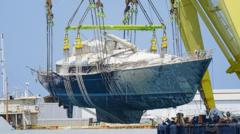The Monreale Cathedral, perched on a hill overlooking Palermo in Sicily, has recently undergone significant restoration, bringing its magnificent mosaics back to life. Recognized as a UNESCO World Heritage Site since 2015, this 12th-century marvel is celebrated for housing Italy's largest Byzantine-style mosaics, trailing only behind the famous ones found in Istanbul's Hagia Sophia.
These mosaics, designed to awe and inspire, stretch over 6,400 square meters and contain around 2.2 kg of pure gold, a material commonly used in Byzantine art to symbolize divine beauty. The restoration was extensive, taking over a year to complete, during which the cathedral resembled a construction site, with scaffolding set up throughout its ornate interior.
Led by local experts from the Italian Ministry of Culture, the project began with the careful removal of layers of dirt that had settled on the mosaics over decades. Additionally, damaged tiles had their enamel and gold leaf restored, and peeling sections were secured back in place. Father Nicola Gaglio, the previous priest of the cathedral, likened his role to that of a cautious parent overseeing the delicate restoration efforts, noting the team's meticulous approach.
Unexpected challenges arose, particularly when restorers discovered a yellow varnish coating the ceiling that needed to be stripped off layer by layer. In the modern age, the cathedral’s outdated lighting system posed another problem, but comprehensive upgrades have been made to illuminate the mosaics while managing energy costs effectively.
Matteo Cundari, Country Manager of the lighting firm Zumtobel, expressed the importance of creating a lighting design that enhances the beauty of the mosaics while ensuring the system can be replaced easily in the future without harming the cathedral.
The first phase of this restoration effort cost approximately 1.1 million euros, with plans for a second phase focusing on the central nave. As the scaffolding was finally taken down, Father Gaglio shared his overwhelming response to the revitalized mosaics, saying it instilled a deep sense of awe. He emphasized the importance of preserving cultural beauty, highlighting its role in elevating humanity's spirit.
These mosaics, designed to awe and inspire, stretch over 6,400 square meters and contain around 2.2 kg of pure gold, a material commonly used in Byzantine art to symbolize divine beauty. The restoration was extensive, taking over a year to complete, during which the cathedral resembled a construction site, with scaffolding set up throughout its ornate interior.
Led by local experts from the Italian Ministry of Culture, the project began with the careful removal of layers of dirt that had settled on the mosaics over decades. Additionally, damaged tiles had their enamel and gold leaf restored, and peeling sections were secured back in place. Father Nicola Gaglio, the previous priest of the cathedral, likened his role to that of a cautious parent overseeing the delicate restoration efforts, noting the team's meticulous approach.
Unexpected challenges arose, particularly when restorers discovered a yellow varnish coating the ceiling that needed to be stripped off layer by layer. In the modern age, the cathedral’s outdated lighting system posed another problem, but comprehensive upgrades have been made to illuminate the mosaics while managing energy costs effectively.
Matteo Cundari, Country Manager of the lighting firm Zumtobel, expressed the importance of creating a lighting design that enhances the beauty of the mosaics while ensuring the system can be replaced easily in the future without harming the cathedral.
The first phase of this restoration effort cost approximately 1.1 million euros, with plans for a second phase focusing on the central nave. As the scaffolding was finally taken down, Father Gaglio shared his overwhelming response to the revitalized mosaics, saying it instilled a deep sense of awe. He emphasized the importance of preserving cultural beauty, highlighting its role in elevating humanity's spirit.

















